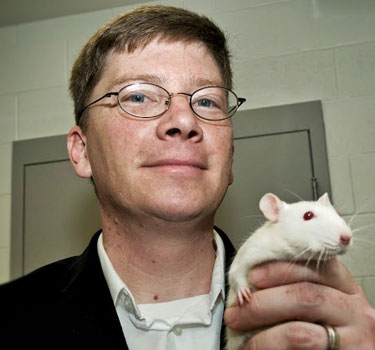This article is more than 1 year old
Rats with GPS backpacks prepare to sniff out landmines
Parachuting rodent Skinner squad training to deploy
Scientists in the US have developed a novel system for detecting landmines by training rats equipped with GPS and wireless rucksacks to sniff out explosives and map them for destruction.
A team of boffins at Bucknell University has trained the Rattus recruits to identify the chemicals that seep into the ground from land mines, and to circle around them. The rats wear palm-sized backpacks which contain GPS and a wireless transmitter, as well as an electronic reward system as an incentive.
The movement of the animals is tracked on a laptop, which uses an icon-based interface specially designed for people who may have little experience with computers. It maps out potential land mines, will produce a map for the site's clearance, and identify safe routes through the area.
"This is something that could drop out of the sky and give you everything you need to train rodents to sniff out land mines, even if the people who are using it can't read or write," said Kevin Myers, associate professor of psychology at Bucknell University.

'Recruit Rattus reporting for conditioning, sir!'
"Some people think we are sending off rats to blow up mines, and that's absolutely not the case. The process is similar to how bomb-sniffing dogs are trained. We need to train the rats to regard that odor as significant by associating it with a food reward."
Myers and his team trained rats to associate a vibration in the backpack with a food reward for good behavior, until the rat learns to seek out the vibration even after tidbits stopped coming. They are then trained to associate the vibration with finding and moving around the odor of explosive chemicals in the soil.
The technique to train in this way uses legendary American behaviorist B.F Skinner's ideas about applying positive and negative reinforcement to train animal subjects. During WWII, Skinner developed a pigeon-guided missile system, with the bird trained to peck at the target, aiming a Pelican guided bomb at German shipping. But the project was dropped, a decision that Winston Churchill's chief scientific advisor described as regrettable.
But Cold War fears and the shock at how advanced Germany have evolved missile guidance systems led to a resumption of the project in 1948 under the title Project Orcon. Pigeons successfully guided simulated missiles travelling at 600mph towards filmed targets, but their accuracy was soon outpaced by electronics and the project was dropped in the early 1950s.
Now the team at Bucknell University, with defense contractor Coherent Technical Services, has received a $100,000 contract to develop their system into a ruggedized unit that can be dropped from an aircraft at remote locations. This would contain everything needed to train the rats and use them to identify possible landmines that may never have been cleared. If this is successful, the next phase will be a $750,000 contract to bring the entire system to deployment stage and to start testing it.
"The task is to design apparatus and a procedure to do this more efficiently," Myers said. "How do you design a Skinner box so it can be used by someone who doesn't speak English, or doesn't have academic training in behavioral psychology? How do you make it rugged so you can drop it out of a plane?"
An airborne army of mine-sniffing rodents might sound like science fiction, but with an estimated 20,000 people killed by landmines around the world each year, and many times that number maimed, mankind's most common mammalian associate's ubiquity could prove useful. ®
